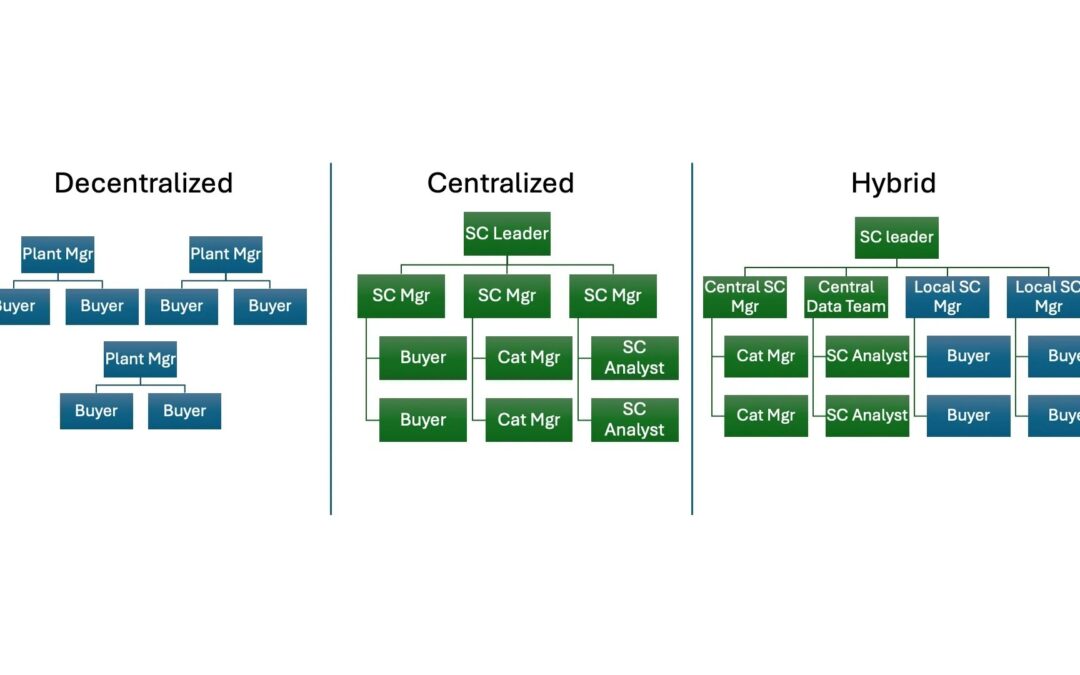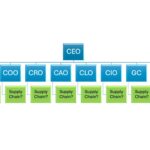Recently we’ve been talking about which C-suite role a supply chain team reports to, both the more common executive leaders and the less common ones. So today we’re going to talk a bit about the structure of a supply chain team in an organization. In particular, we’ll cover four structures: No formal supply chain, decentralized, centralized, and hybrid.
No Formal Supply Chain
Especially in small or startup organizations, sometimes there is no formal supply chain, procurement, or logistics team. In this structure, the front line employees (usually engineers, perhaps line managers, admins, and other middle management) hold P-Cards and purchase the majority of the company’s needs using those P-Cards or the occasional formal Purchase Order drawn up by Finance or Accounting. The advantage of this structure is that it’s easy, and happens organically. One founder in an organization has a credit card, then they hire someone and give that person a P-Card, and pretty soon this is the structure in place for all supplier cash flow. This can work for a little while, but has all the disadvantages P-Cards bring: Lack of spend control or visibility, having to “catch up” with expenses after the money is already spent, and high administrative costs for (usually) Accounting. Yes, p-cards give you a little rebate. But that rebate is nothing compared to what a good procurement professional can negotiate. Once spend hits even two million dollars, one procurement professional can easily earn their own keep. The math: negotiating a 10% savings below “retail” prices of $2m saves the company $200,000/year in addition to the risk reduction that comes from formal supplier management. A business reaches $2m in spend per year extremely quickly, so this is an easy threshold to cross.
Decentralized
A decentralized supply chain means there are multiple teams supporting the supply chain across a business. This can be buyers each reporting to a plant manager, or each business within a conglomerate having a separate supply chain/procurement/purchasing team supporting them and reporting to that individual business’ management team. The advantage of a decentralized structure is that it provides better internal customer service. The buyers are directly accountable to the local business leader, and feel the “pain” when something goes wrong. For example, when a production line goes down, the line manager can often physically take the buyer down to that line and point to the part or equipment component causing the line outage, making that situation more “real” to the buyer. The direct connection in the decentralized structure leads to a greater sense of urgency and at least the perception that an issue is resolved more quickly. Local management can see the supply chain team working on their business’ behalf. It is worth noting that with really good category management and contracts in place (in any structure), issue resolution can happen just as quickly but is almost always less visible. The disadvantage of the decentralized structure is redundancy and a lack of leverage. Often multiple people are doing the same job, working with the same suppliers, and managing the same spend categories.
Centralized
A centralized supply chain means there is one supply chain team reporting up to one supply chain leader, no matter the organization’s size or number of locations. The centralized team is often located in one region or office (but not always, especially with post-COVID remote and hybrid work), and has one set of metrics and goals. In conglomerated businesses, the centralized supply chain team works for the “parent” company instead of the subsidiary businesses. The biggest advantage of a centralized supply chain team is the ability to leverage the full spend of the business in the market because every contract or bid considers all of the spend for a given category. For example, a centralized supply chain team can bundle together all of the office supplies needed and get a much larger discount on those common materials than each individual business can negotiate on its own. A centralized team also requires fewer resources because it removes the personnel redundancies found in a decentralized team. The main disadvantage of a centralized supply chain is “ivory tower syndrome” where the supply chain team is perceived as out of touch with its internal customers. Internal customers often get confused on which supply chain team member to call about an issue, which is especially true if the centralized team habitually says, “Oh, I’m not the right person, you have to call this person” and leaves it at that. In a centralized team, the leadership has to ensure the team takes responsibility for any call they receive, whether it is about “their” category or not, in order to preserve a high level of customer service.
Hybrid
As with most things in corporate life, the best answer is often a hybrid structure. A hybrid supply chain team has some team members managing categories and commodities centrally, and some working with local customers at the point of service. Categories are typically assigned to either the central or decentralized teams, and vary by business need. Some examples of central categories might be major common direct materials (such as the top 20% of items by spend), office supplies, travel such as hotel and airline contracts, and Human Resources services. Some decentralized categories might include line equipment parts and maintenance, facilities, specialized materials to a particular site or plant, and construction projects. The advantage of a hybrid structure is that it can take on the best aspects of both the centralized and decentralized models. The company can leverage all of its spend on key categories, but still have local buyers available for internal customers. The disadvantage of this structure is the conflict that will occur between the central and local teams. Metrics must be chosen carefully to ensure the two parts of the team are pulling in the same direction and focused on the same goals. The business must also carefully decide if the local teams will report through the central supply chain leader or their local leaders, either intensifying or closing this inherent rift. It helps to be very explicit about whether the central team is there to support the local teams (a more customer service-oriented approach) or the local teams are there to support the central team (a more cost savings-oriented approach). Either structure can work, but if the teams are “separate but equal”, there will be conflict as each vies for power. This will intensify if the organization is trying to keep headcount low as each team competes for limited personnel resources.
As with all org chart considerations, these structures both solve and cause problems. While an ideal state would be helpful, there is no such thing and all variations of centralization carry benefits and risks. A strong supply chain leader can help smooth out the risks and improve the success of any structure, because at the end of the day any team structure is about its people.




